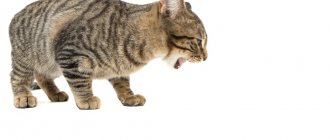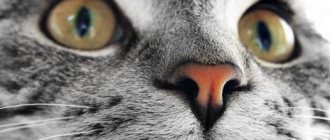An important indicator that can signal serious troubles associated with a cat’s health is the darkening of the color of its urine. Having barely noticed this problem, the owner must immediately contact a veterinarian to receive qualified help. At the same time, it is necessary to control not only the color of urine, but also the smell and transparency. These indicators can become symptoms of a large number of serious diseases associated with the liver, urinary tract diseases or dehydration. Why do cats have dark urine, and what should the owner do to protect the animal from unpleasant consequences? The answers are further in the article.
How to determine the color of urine in cats
The urine of a healthy cat has an unsaturated yellowish or amber color. Urobilin gives urine a straw-colored hue, which must be removed from the blood, since a high concentration of this bile pigment in the body leads to a negative effect on the cat’s nervous system.
If the urine is too rich or dark in color, this indicates problems in the animal’s body that need to be addressed urgently. The difficulty is that assessing the color of urine in cats can sometimes be difficult. The reason for this is the habit of most individuals to go to the toilet on a tray with filler. In order to be able to systematically control the tone of your cat’s discharge, you should train him to go to an empty litter box. After your pet relieves itself, you need to pour the liquid into a transparent container and place it against the background of a white sheet of paper. With this method, color deviations can be easily determined. A piece of clean white cloth placed directly on top of the cat litter can also help assess urine status.
It is worth noting that clear urine in a cat can also be a warning sign. In most cases, this is an indicator that the animal drank a lot of water and the body did not have time to secrete the required amount of urobilin, so the discharge does not have a yellowish tint. But in some situations, the absence of a characteristic color of urine indicates pathologies of the endocrine glands, diseases of the adrenal glands, or diabetes mellitus. There is a high probability of having one of these diseases in those cats that are constantly lethargic and have no appetite for a long time. If the owner notices these symptoms in his pet, he must contact a veterinarian to prescribe appropriate treatment.
Treatment
If the cat’s urine is dark brown, and the diagnosis shows the presence of one of the diseases listed above, then the doctor will select an individual treatment regimen. Depending on the condition of the furry patient, the following may be prescribed:
- Antispasmodics and painkillers.
- Immunomodulators.
- Antibiotics that help fight infections.
- Restorative droppers.
- In some cases, surgical intervention is not possible. Then the doctor will prepare your pet for surgery.
Be sure to control the amount of water you drink. Sometimes special foods are prescribed that provoke thirst. If your pet continues to refuse, then try to stimulate him in every way. Install a decorative fountain and a small aquarium with artificial fish.
Read also: Liquid sperm, what to do?
Causes of urine color change
Dark urine can appear in a pet as a result of both ordinary physiological reasons and serious diseases. In any case, they need to be identified in order to provide the correct treatment if necessary.
The main reasons for changes in the color of urine:
- infections in the genitourinary system;
- sand and stones in the genitourinary system;
- dehydration of the body;
- reproductive system;
- estrus;
- other serious illnesses requiring medical care, and in some cases, operations.
Kidney functions
The main job of the kidneys is to remove toxins from the body. It also forms urine, which contains:
- excess liquids, mineral salts, organic substances;
- uric acid;
- urea;
- ammonia, other metabolic products.
Urine flows down the ureters into the bladder, then comes out during emptying.
Other features
- Maintaining water, electrolyte, acid-base balance;
- regulation of blood pressure;
- removal of excess calcium;
- production of the active form of hormone D;
- synthesis of the hormone erythropoietin, which is responsible for the creation of red blood cells in the bone marrow.
Options for changing urine color
By the shade of urine you can roughly determine what problem caused its darkening. But you should not start treatment on your own based on these data. It is better to contact a specialist who will determine the causes of this phenomenon and advise the correct methods of therapy.
Possible options for changing the shade of urine:
- Bright yellow urine is a sign of mild dehydration. It is observed in cats who have not drunk for a long time in hot weather, or in the first week after surgery and sterilization as a result of a long-term diet. Such dehydration eliminates the danger to the body, provided that the animal receives a sufficient amount of water.
- Pink-red urine can indicate a number of common problems in cats, including urinary tract infections, bladder or kidney stones, and cystitis. If pink discharge is found in a castrated cat, then this is a sign of the presence of kidney stones and cystitis at the same time. In this case, sand and stones go into the bladder, causing it to be injured, ulcers and erosions form, which provoke the development of infection. The constant presence of blood in a cat’s urine requires immediate treatment, because delaying medical help can lead to the death of the animal. In some cases, red urine may indicate injury due to bruising of internal organs.
- Brown urine often indicates high levels of bacteria. Low blood clotting can also cause this problem. In any case, the animal loses weight, appetite and interest in everything around it. When such urine appears in cats, it is possible to develop blood parasitic infections and leptospirosis - very serious diseases. Mature cats that are ready to mate may also have brown urine. In this case, there is no need to worry about the animal, since dark urine is obtained from mixing urine with menstrual flow.
- Bloody urine indicates severe cases of glomerulonephritis and pyelonephritis.
- Greenish or green-yellow urine indicates liver damage, which leads to parenchymal jaundice. The result of such a disease can be a neuropathic attack and death.
Most often, darkening of a cat’s urine indicates problems with the genitourinary system. These are very serious illnesses that require immediate medical attention.
Diagnosis of diseases
Before contacting the veterinary clinic, the animal should be kept on a fasting diet for 8-12 hours. At the same time, he retains free access to drinking water. The doctor will definitely prescribe not only a urine test, but also a general and biochemical blood test, which is taken on an empty stomach. The absence of food in the stomach and intestines will facilitate an ultrasound examination of the kidneys and bladder. In order not to prolong the diagnosis, you can prepare and collect urine in advance. Pet stores sell special filler that does not absorb liquid. Using a sterile syringe, 30-50 ml of urine is drawn into a special container and delivered to the laboratory within 3 hours. At the first stage, these examinations are enough to determine the amount of drug therapy and the need for surgical intervention.
Return to contents
Prevention
It is better to prevent any disease than to later spend much more time and money fighting a serious illness. For animals, the issue is especially acute, because any problems with their health completely depend on the owners, who, in most cases, ignore unpleasant symptoms in the first stages. As a result, pets have severe complications that even experienced specialists cannot cure. Therefore, the first action that an owner should take if he notices that a cat has dark urine is to show the animal to a veterinarian to rule out dangerous health problems and prescribe the correct treatment individually for a particular individual. Moreover, serious illnesses are accompanied by other unpleasant symptoms that are difficult to ignore.
Observation of the cat owner is the best preventative measure for minimizing the risk of death, or carrying out complex treatment, which includes surgery.
Manifestations of bile stagnation
- Skin itching. The symptom worsens in the evening and after contact of the skin with warm water. This provokes the appearance of scratches and pustular rashes on the skin. The patient becomes anxious, irritable, and suffers from insomnia.
- Feeling of fullness and pain in the hypochondrium on the right side. The latter can “give” to the right shoulder blade, arm, collarbone, and lumbar region.
- Changes in skin and mucous color. This usually manifests itself as yellowing of the sclera of the eyes, then the yellowness spreads to other parts of the body. Hyperpigmentation, a darkening of the skin, may also occur.
- Abnormal stool. Cholestasis is characterized by discolored yellow, gray or white stool. Due to the abundance of fats, it becomes liquid and has a foul odor. Later, indigestion and constipation occur.
- Skin formations. You can see xanthomas (thickened areas of rough skin on the body that are brown or yellow) on the chest, back, and elbows. Symmetrical yellow formations on the eyelids are called xanthelasmas. They appear when the amount of cholesterol in the blood increases for three or more months and may disappear after it normalizes.
- Dyspeptic disorders. There is a bitter taste in the mouth, nausea and vomiting are noted. Appetite is often reduced or absent, causing the patient to lose weight.
- Darkening of urine. The released liquid changes from straw-yellow to the color of “dark beer.”
- Signs of hypovitaminosis (due to impaired absorption of fats, the absorption of fat-soluble vitamins - A, D, E, K) is impaired. With prolonged cholestasis, vitamin K is not sufficiently absorbed from the intestine, and increased bleeding occurs. Vitamin D deficiency is accompanied by brittle bones and pain in the limbs and back. With poor absorption of vitamin A, distance vision deteriorates, and a person sees worse in the dark. Vitamin E deficiency reduces libido.
Introduction to the problem
The color of urine is an important indicator of a cat's health. Normally it is light, may have a yellow tint or is almost transparent. Darkening may indicate serious problems with your pet's health. Having noticed this, you cannot expect the problem to disappear on its own. You need to seek help immediately.
It is best if you arrive at your appointment already with a portion of urine. Then the doctor can evaluate its color, smell and take a part for laboratory analysis. Dark urine in a cat may indicate serious diseases associated with the liver, diseases of the genitourinary system, or dehydration.
The danger of poor kidney function
Impaired kidney function at any stage of urine excretion or formation is fraught with problems. The fact is that urine contains a large amount of toxins and metabolic products. If the outflow of urine is impaired, then these substances will accumulate in the body and poison it. This process is called autointoxication. Substances such as:
- ammonia;
- urea;
- creatinine;
- protein breakdown products that are highly toxic.
The result will be disruption of the functioning of organs and metabolic processes. In high concentrations, substances can cause irreversible damage and death. It is important to know what symptoms indicate poor kidney function.
Recommendations for the owner
While the doctors are investigating and finding out why the cat has dark urine, you need to calm down and organize appropriate conditions for the patient for treatment and recovery. First of all, you need to maintain a drinking regime and avoid dehydration. When a disease is detected, a specialist prescribes a strict diet. It completely excludes raw meat and fish.
At the same time, it is desirable to ensure maximum rest for the patient. It is better to limit movement within one room. But here nature comes to the rescue. If an animal feels unwell, it sleeps more often.
Let's go to the clinic
The animal should not be fed 8 hours before visiting the veterinarian. This is important because all analyzes will be more informative and accurate. Prepare the tray by morning. To do this, remove all the filler from it and wash it thoroughly. Lay the mesh on top. If the cat is used to scooping up the litter with its paws, then place a piece of sterile gauze.
Using a sterile syringe, collect 40 to 80 ml of urine. Within two hours, the jar must be delivered to the clinic for laboratory testing. In addition to examination and urine analysis, the veterinarian performs an ultrasound. If necessary, a general and biochemical blood test is prescribed. If a cat's urine is dark brown, then it is often impossible to wait for the results of all tests. Therefore, based on the initial examination, a course of treatment begins, which will be adjusted as other laboratory findings are received.
Preparing for the OAM test for cystitis
On the day before taking biomaterial, it is advisable to refrain from physical activity, drinking alcohol, and not eat vegetables and fruits (beets, carrots, citrus fruits, watermelons), red wine, and multivitamins, which can change the color of urine.
Avoid taking diuretics for 48 hours before urine collection (in consultation with your doctor).
Urine should be collected before starting antibiotic therapy.
Carry out a thorough toileting of the external genitalia under the shower with soap (it is prohibited to use hygiene products with antiseptics). For men, pull back the foreskin of the penis, wash the head well with warm water, and dry with a paper towel.
Women during menstruation should place a tampon in the vagina before collecting urine and inform the attending physician that the test was performed during menstruation.











